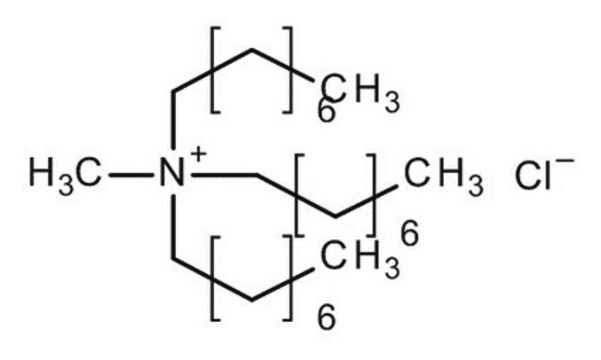Products may be shipped at a different temperature than the recommended long-term storage temperature. If the product quality is sensitive to short-term exposure to conditions other than the recommended long-term storage, it will be shipped on wet or dry-ice. If the product quality is NOT affected by short-term exposure to conditions other than the recommended long-term storage, it will be shipped at ambient temperature. As shipping routes are configured for minimum transit times, shipping at ambient temperature helps control shipping costs for our customers. For more information, please refer to the Storage and Transport Conditions document: https://www.sigmaaldrich.com/deepweb/assets/sigmaaldrich/marketing/global/documents/316/622/storage-transport-conditions-mk.pdf
69485
Methyltrioctylammonium chloride
≥97.0% (AT)
Synonyme(s) :
Trioctylmethylammonium chloride
Sélectionner une taille de conditionnement
98,00 €
Sélectionner une taille de conditionnement
About This Item
98,00 €
Produits recommandés
Niveau de qualité
Essai
≥97.0% (AT)
Impuretés
~1% water
Chaîne SMILES
[Cl-].CCCCCCCC[N+](C)(CCCCCCCC)CCCCCCCC
InChI
1S/C25H54N.ClH/c1-5-8-11-14-17-20-23-26(4,24-21-18-15-12-9-6-2)25-22-19-16-13-10-7-3;/h5-25H2,1-4H3;1H/q+1;/p-1
Clé InChI
XKBGEWXEAPTVCK-UHFFFAOYSA-M
Vous recherchez des produits similaires ? Visite Guide de comparaison des produits
Catégories apparentées
Application
- As a catalyst in the synthesis of acridine dione derivatives from aromatic aldehyde, dimedone and amines under ultrasonic irradiations.[1]
- As a catalyst in the synthesis of extended π-systems using aromatic aldehydes and methyldiazines.[2]
- As a component of a catalytic system used in the Suzuki-Miyaura cross-coupling reaction of a variety of aryl and heteroaryl chlorides in H2O.[3]
Mention d'avertissement
Danger
Mentions de danger
Classification des risques
Acute Tox. 3 Oral - Aquatic Acute 1 - Aquatic Chronic 1 - Eye Dam. 1 - Repr. 1B - Skin Corr. 1A - STOT RE 2
Code de la classe de stockage
6.1A - Combustible acute toxic Cat. 1 and 2 / very toxic hazardous materials
Classe de danger pour l'eau (WGK)
WGK 3
Point d'éclair (°F)
235.4 °F
Point d'éclair (°C)
113 °C
Équipement de protection individuelle
dust mask type N95 (US), Eyeshields, Faceshields, Gloves
Faites votre choix parmi les versions les plus récentes :
Déjà en possession de ce produit ?
Retrouvez la documentation relative aux produits que vous avez récemment achetés dans la Bibliothèque de documents.
Les clients ont également consulté
-
How is shipping temperature determined? And how is it related to the product storage temperature?
1 answer-
Helpful?
-
-
How can I determine the shelf life / expiration / retest date of this product?
1 answer-
If this product has an expiration or retest date, it will be shown on the Certificate of Analysis (COA, CofA). If there is no retest or expiration date listed on the product's COA, we do not have suitable stability data to determine a shelf life. For these products, the only date on the COA will be the release date; a retest, expiration, or use-by-date will not be displayed.
For all products, we recommend handling per defined conditions as printed in our product literature and website product descriptions. We recommend that products should be routinely inspected by customers to ensure they perform as expected.
For products without retest or expiration dates, our standard warranty of 1 year from the date of shipment is applicable.
For more information, please refer to the Product Dating Information document: https://www.sigmaaldrich.com/deepweb/assets/sigmaaldrich/marketing/global/documents/449/386/product-dating-information-mk.pdfHelpful?
-
-
Hi! What gloves are appropriate whilst handling methyltrioctylammonium chloride? The SDS only says gloves are "required" and fails to adress any actual requirements/standards.
1 answer-
The type of gloves recommended to handle this product are KCL 741 Dermatril® L.
Please refer to section 8.2 of the product Safety Data Sheet for this information.
Helpful?
-
Active Filters
Notre équipe de scientifiques dispose d'une expérience dans tous les secteurs de la recherche, notamment en sciences de la vie, science des matériaux, synthèse chimique, chromatographie, analyse et dans de nombreux autres domaines..
Contacter notre Service technique















